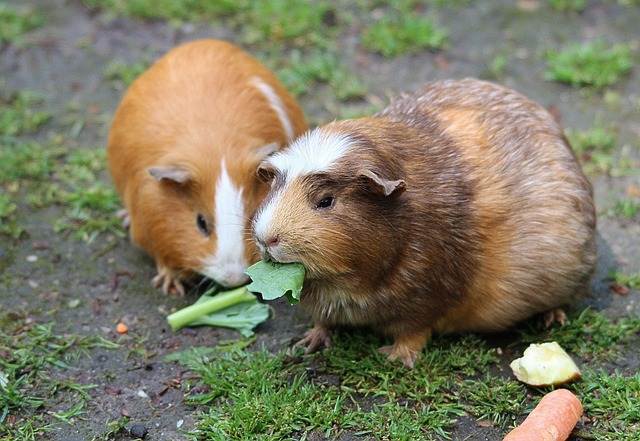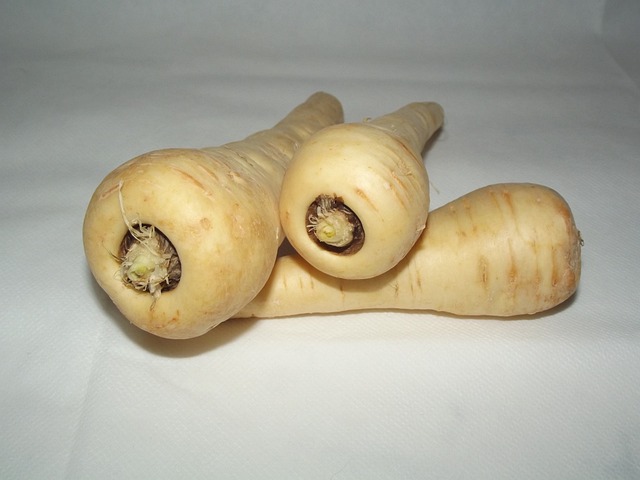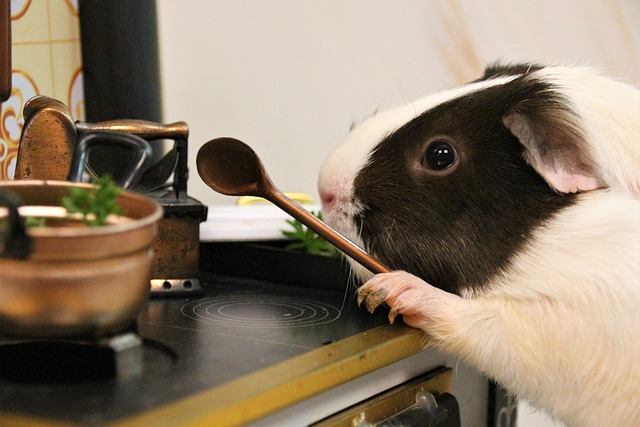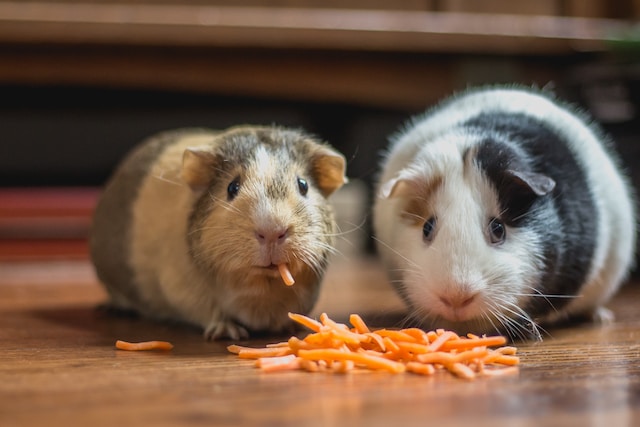A guinea pig’s diet should be balanced and rich in essential nutrients and fresh veggies – that’s what we know for a fact.
Parsnips are largely available and kinda remind white carrots and parsley (by taste) at the same time, but can guinea pigs eat parsnips safely?
Parsnips are safe for guinea pigs to eat 2-3 times/week but not daily because of oxalates and sugar. They contain vitamins, minerals and other nutrients, but some piggies simply don’t like them or have stomach ache after eating parsnips.

Let’s find out how much parsnip is safe to feed your guines pig and what can be some downsides.
Table of Contents
Can Guinea Pigs Eat Parsnips? Is it safe?
Guinea pigs are herbivores and like root vegetable, but they can only eat Raw parsnips in moderation or as an occasional treat if they like it.
Parsnips are sweet-ish root vegetables, with earthy flavor and some bitterness and a smell not all guinea pigs like.
Parsnips are close relatives to carrots and parsley but while guinea pigs truly love carrots, not all guinea pigs equally love a slice of parsnip.
Wild parsnips along with some you bought in the market are both ok for cavies as long as they weren’t treated with anything.
When I had guinea pigs they were very picky about vegetables and they wouldn’t even look at parsnip!
I wonder where they learn their pickiness (not from me!!).
Can guinea pigs eat cooked parsnips?
Guinea pigs should not eat cooked parsnips as cooking parsnips takes away some healthy stuff and guinea pigs cannot really process and digest cooked parsnips.
If you gave cooked parsnip by mistake, your piggy will have upset stomach and may throw up.
Can guinea pigs eat parsnips peels or skin?
Guinea pigs can eat parsnip skin and peels safely.
If you’re not sure if the parsnip was treated with any chemicals or pesticides it is better to peel it before feeding your guinea pig.
If it is a fresh parsnip from the garden, a piggy will happily nibble on some peels, or a parsnip slice with skin. Peelings are a great source of fiber for guinea pigs.
Just make sure to thoroughly wash it first.
Can guinea pigs eat parsnips tops?
Parsnips tops are of the favorite parts of a parsnip that guinea pigs can (and like) to eat, just like carrot tops!
And great exercise for their ever-growing teeth.
Can guinea pigs eat parsnip leaves?
Nothing better to nibble on fresh leaves for a guinea piggy! But not if it’s parsnip.
Parsnips leaves can be toxic for guinea pigs and they also are the part that are exposed during growing and if there were any insects or pesticides, leaves can still have a trace of it.
Leaves however contain some minerals, vitamins C and K and also help blood clotting.
So I would only recommend for your cavy to eat parsnip greens in strict moderation and if had previous digestion issues, skip it.
Health Benefits Of Parsnips For Guinea Pigs
Veggies are good to add to both human and pet’s diet, we know that. But how good are parsnips exactly for little piggy’s diet?
Parsnips have many health benefits for rodents, mainly because of vitamins C and K, potassium, folate, magnesium,calcium, dietary fiber and low fat content.
- help stabilize blood pressure
- contain vitamin c vital for guinea pigs
- vitamin k helps with cardiovascular health
- rich in dietary fiber
- minerals – parsnip has lots of potassium, but also magnesium, a little bit of iron and calcium.
- excellent nutritional value

Nutritional Value of Parsnips for Guinea Pigs
Average parsnip weights around 110 to 250 gr (4oz to 9 oz).
Your piggy’s diet probably includes several vegetables so they won’t eat the whole parsnip in one go, just a few slices.
| Nutrients | Amount in 100 gr |
|---|---|
| Calories | 75 kcal |
| Water | 79.5 g |
| Carbohydrates | 18 g |
| Fiber | 4.9 g |
| Protein | 1.2 g |
| Fat | 0.3 g |
| Sugar | 4.8 g |
| Calcium | 36 mg |
| Copper | 0.12 mg |
| Phosphorus | 71 mg |
| Vitamin C | 17 mg |
| Vitamin K | 22.5 µg |
| Vitamin E | 1.49 mg |
| Folate | 67 mcg |
| Magnesium | 29 mg |
| Potassium | 375 mg |
| Selenium | 1.8 µg |
Vitamin C
Vitamin C is quite vital for piggies for a number reasons:
- they can only get it from food or supplements
- Vitamin C helps prevent lethal guinea pigs condition called scurvy.
- It helps their body heal itself if something is wrong.
- It boosts immune systems and helps building collagen and keep little piggies’ brains healthy.
While parsnips don’t have as much vit C as broccoli or kale, they still contain some and it is more than, for example, cucumbers.
Veterinarians say your guinea pig should have around 10 to 50 mg of Vitamin C perf day, and just a few slices of parsnips won’t be enough.
Mix it with red bell peppers or broccoli.
Healthy heart and blood
Parsnip and especially leaves help strengthen guinea pig’s cardiovascular health and coagulation.
Which means if your pet is injured or sick it won’t easily bleed out.
Vitamin K and minerals like potassium, iron in parsnips also keep blood pressure in a healthy range by balancing water-electrolytes ratio.
Parsnip also has a bit of copper (quite small amount) that plays a big role in red blood cells formation – it helps pigs absorb iron and prevents anemia.
Parsnips have also very little fat that is good to keep good heart condition for small pets.
Antioxidants
Antioxidants help guinea pigs’ bodies fight inflammation and some source say they even prevent cancer.
Preventing inflammation and keep healthy immune system is very important for cavies as they fight viruses, infection and diseases quite bad.
Aside from antioxidants, there are also folates in parsnips that help with growing good and healthy cells.
No weight gain
A few slices of parsnips are low in calories and fat so they help keep balanced diet and healthy weight for a guinea pig.
Good content of dietary fiber also prevents constipation and bloating in little piggies.
Healthy bones and muscles
Magnesium from parsnips help keep little piggies’ musles strong and in good recovering speed and prevent seizures.
Calcium from parsnips is good for a younger cavy to keep healthy skeleton development.
Overall health
Good sleep, reduced anxiety, reduced risk of diabetes and rheumatism are some of health bonuses for guinea pigs that have parsnips as a snack.
Parsnips are quite dense that helps guinea pigs really use their teeth and keep them in good shape, as cavies’ teeth keep growing and they need some exercise.
Dietary fiber in parsnips helps keep cholesterol levels in a healthy range.
Apart from parsnips any vegetable rich in magnesium can do that too.
Risks of Feeding Parsnips to Guinea Pigs
- kidney stones
- digestive system issues
- diabetes
- bladder stones
- oxalates
- rarely – allergies

Urinary problems
Urinary problems are most commonly associated with excessive eating of parsnips in older guinea pigs.
That is due to calcium in parsnip.
It is great to keep young guinea pigs bones healthy, but in adult and older pigs it can cause accumulation and calcification.
Which can lead to stones in bladder or kidneys, or even pain and blood when the guinea pig is peeing.
High Sugar Content
As for humans, sugar should be in moderation for guinea pigs.
50 gr of parsnips already contain around 2.5 gr of sugar.
Eating too much vegetables or treats high on sugar can lead to diabetes, overweight, digestive problems, inconsistent stool.
And for piggies having regular good poop is very important as they can only absorb some nutrients by eating their excrements.
Carrots are healthier than parsnips for guinea pigs in terms of sugar.
Oxalates
Parsnips are high in oxalates that can be lethal for guinea pigs and cause urinary problems
There are about 40 mg (0.04 g) of oxalic acid per 3.5 oz or 100 g of parsnip, less than in some leafy greens but still quite a lot for small cavies’ bodies.
That’s why I do not recommend youadd parsnips on a daily basis or make it a sole source of vitamins/minerals for your guinea pig.
How often can guinea pigs eat parsnips?
Guinea pigs can eat parsnips 3 times a week along with other vegetables or as a treat.
Veterinarians don’t recommend feeding parsnips bits or leaves to guinea pigs daily, especially for older animals.
How much parsnip can guinea pigs eat?
Just a few slices of parsnip along with other vegetables is enough for guinea pig’s balanced diet.
I would keep parsnips to only be a third of all veggies in the daily intake your piggy eats.
Some people say to cut parsnip tops and end bit of the parsnips but in fact it can be your pig’s most favorite part.
They do prefer fresh parsnips.
I would skip parsnips if your guinea pig had ever had digestive issues.
If you want to just give parsnip as a snack there are special prepackaged tiny bits that pigs love to nibble on.
Do Guinea Pigs Like To Eat Parsnips?
Whether your guinea pig will like or not some parsnip comes down to their personality!
They look like a white carrot a bit so your guinea pig may be curious to try.
Most are quite naughty and picky and won’t touch any part of parsnips, maybe because they dislike the smell.
But other guinea pigs will like the best the thin end bit and the top, with some green leaves still on, fresh from the garden.
Guinea pigs with a sweet tooth seem to like parsnip more.
Give it a try!
Alternatives to Parsnips for Guinea Pigs
If your guinea pig didn’t appreciate your effort with a wild parsnip, these are just some healthy and safe parsnip alternatives you can add to your guinea pig diet and keep up a 1-cup veggies per day norm:
- Turnips
- Carrots – one of the favorite and safest guinea pigs’ food
- Winter squash
- Parsley
- Raddish,
- Celery – another common food for piggies
- Kale – an amazing source of Vitamin C
- Broccoli – another great source of Vitamin C
- Cucumbers – contain lots of water to keep a high hydration level

How to prepare parsnip for guinea pigs?
You should only serve raw parsnips to your guinea pigs. Do not cook parsnips for guinea pigs.
- Choose fresh parsnip with good skin, no mold or traces of insects biting them
- Wash it thoroughly
- If it is the first try, keep the skin on and cut thin slices. Do not cut the top or end bit (some cavies like those)
- Let the guinea pig try one slice.
- Observe what part is your piggy’s favorite (if any)
- If your piggy isn’t interested, you can peel the parsnip and try again.
- Ultimately, some guinea pigs don’t like parsnip at all so you can switch to an alternative.
FAQ
Can guinea pigs eat parsnip and turnip?
Parsnips and turnips are safe vegetables for guinea pigs’ diet. However, your should feed parsnips in moderation for older guinea pigs as they may have urinary issues.
My guinea pig ate a whole parsnip?
You should only give a few slices of parsnip to your guinea pig.
If they eat a whole vegetable, they can vomit or have some stomach pain.
Can guinea pigs eat parsnips and tomatoes?
Tomatoes and parsnips are healthy and safe foods for guinea pigs and a good source of nutrients.
Conclusion: Are parsnips good for guinea pigs after all?
I’d say parsnips are relatively safe root vegetables for guinea pigs but also they are better for younger piggies.
I would recommend testing if your guinea pig will like parsnip at all first as they are not one of the favorite foods for them.
If yes, add it two or three times a week as along with other vegetables to compensate for minerals and vitamins parsnip doesn’t have.
There are definitely better veggies to feed guinea pigs that are also more suitable for a regular diet.
If you don’t like the risk, do try some veggies. As a guinea pig owner who lost 2 of my babies, I prefer to stay cautious.
Healthy nibbles for your piggies!

3 thoughts on “Can Guinea Pigs Eat Parsnips? Safe serving, Risks & Benefits”